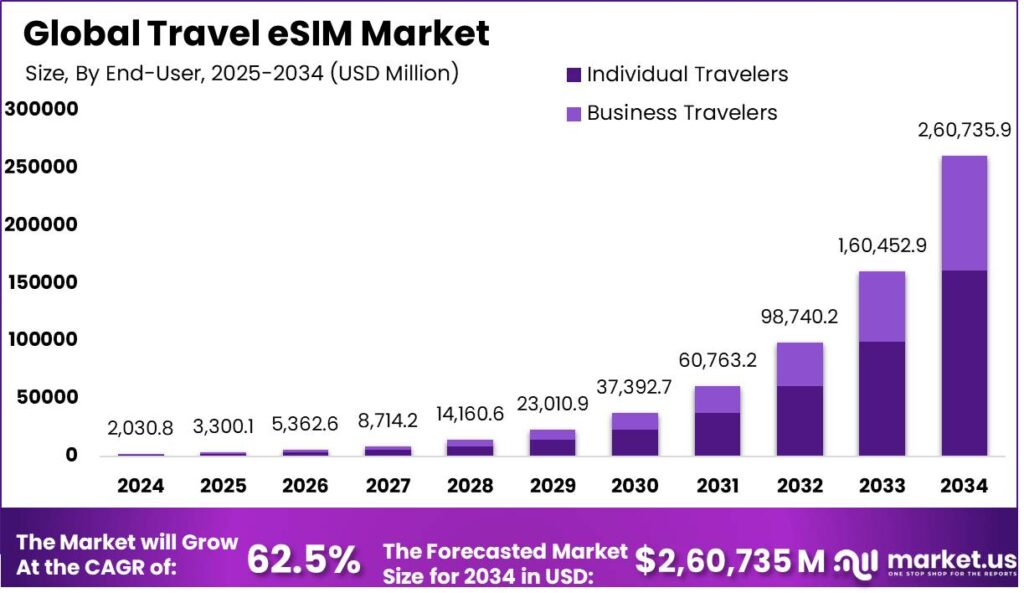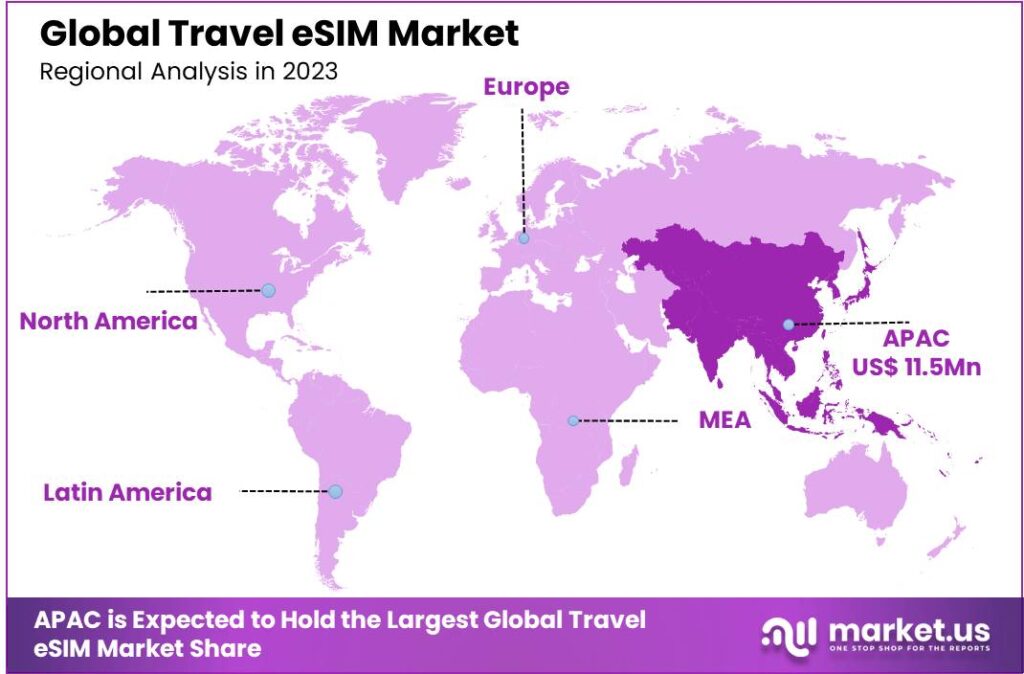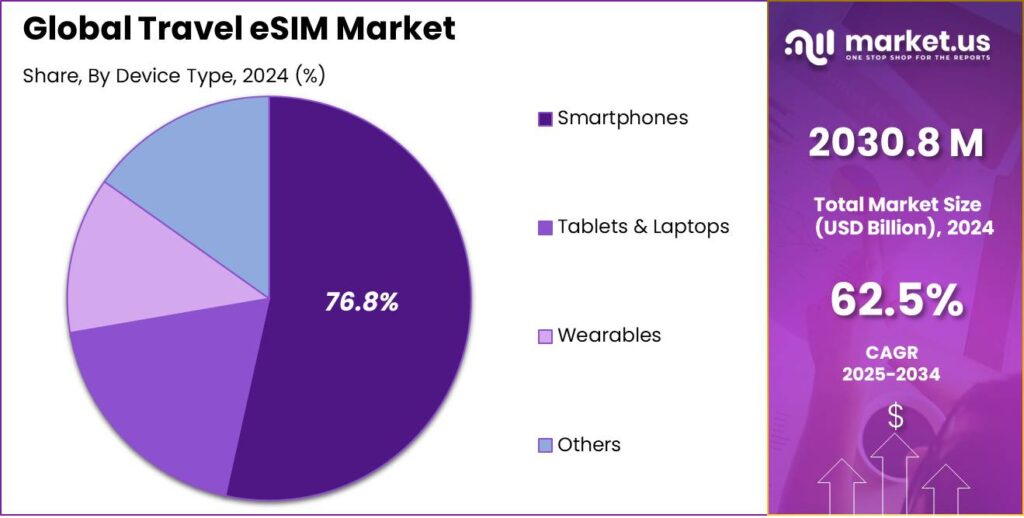Table of Contents
Report Overview
As per Market.us Report, The Global Travel eSIM Market is poised for significant growth, with an estimated value of USD 2,60,735 million by 2034, up from USD 2,030.8 million in 2024. This impressive rise represents a CAGR of 62.50% between 2025 and 2034. In 2024, the Asia-Pacific region led the market, commanding a dominant share of over 56.7% and generating USD 11.5 million in revenue.
A travel eSIM is a digital solution that lets you stay connected to mobile networks while traveling abroad, without the hassle of swapping out your physical SIM card. Embedded directly into your device whether it’s a smartphone, tablet, or smartwatch it provides seamless access to local networks, making international travel easier and more convenient.
The growth of travel eSIMs is primarily driven by the increasing globalization of business and leisure travel. As travelers seek seamless connectivity options across borders, eSIMs offer a more flexible and convenient alternative to traditional SIM cards. They eliminate the need to physically swap SIMs for different countries, enhancing user experience and connectivity. The rise of travel eSIMs is also fueled by the growing adoption of eSIM-compatible devices like smartphones, tablets, and wearables, enabling users to manage mobile subscriptions digitally.
Travel eSIMs are mainly used in smartphones, tablets, and wearables, providing easy access to voice and data services without the need for local SIM cards. They allow travelers to stay connected while on the move, even without their primary device. For businesses, travel eSIMs streamline communication management for employees traveling internationally, simplifying administration and enhancing cost efficiency, especially for multinational corporations with global communication needs.

Key challenges in the travel eSIM market include uneven adoption rates among carriers globally, leading to limited functionality and inconsistent user experiences. Compatibility issues between devices and network providers also present obstacles. Additionally, security concerns around data privacy and personal information management require careful attention to ensure trust and safety in eSIM technology.
Innovation in eSIM technology is focused on improving security and user experience. Advanced encryption is being developed to protect personal information, while machine learning and AI are enhancing eSIM management by predicting user preferences and automating subscription changes. Additionally, the integration of eSIMs with IoT devices is broadening their applications, enabling global connectivity without physical SIM cards.
Market expansion for travel eSIMs is driven by increased smartphone penetration, growing consumer awareness, and improvements in telecommunications infrastructure in emerging economies. Regulatory support is further promoting eSIM adoption. As the technology becomes more standardized, its use in the travel sector is expected to grow, offering broader global coverage and better connectivity for international travelers.
Key Takeaways
- The Global Travel eSIM Market is projected to reach USD 2,60,735 Million by 2034, up from USD 2,030.8 Million in 2024, with a remarkable CAGR of 62.50% during the forecast period from 2025 to 2034.
- In 2024, the Smartphones segment led the Travel eSIM market, holding an impressive 76.8% of the market share.
- The Individual Travelers segment also dominated in 2024, capturing more than 61.9% of the market share.
- Asia-Pacific emerged as the leading region in the Travel eSIM market in 2024, accounting for 56.7% of the market share, generating approximately USD 11.5 billion in revenue.
Regional Analysis
In 2024, the Asia-Pacific region secured a leading position in the Travel eSIM market, accounting for over 56.7% of the market share. This translates to revenue of approximately USD 11.5 million. China, in particular, has demonstrated strong leadership within this sector. The country’s market trajectory is notably promising, thanks to its swift adoption of advanced digital connectivity solutions. Overall, the travel eSIM market reached a valuation of USD 556.1 million in 2024, propelled by various critical factors contributing to its growth.
The remarkable growth in the Asia-Pacific travel eSIM market is driven by the increasing mobility of the population and the rising need for seamless international connectivity. As travel continues to recover and expand following global disruptions, the demand for easily accessible and cost-effective data plans has surged. eSIM technology meets this demand by offering travelers flexible data plans across multiple countries without the need to physically switch SIM cards. This convenience is particularly appealing in a region as diverse and travel-intensive as Asia-Pacific.
Furthermore, technological advancements and regulatory support in countries like China have further facilitated the expansion of the eSIM market. Innovations in smartphone technology, where eSIMs are increasingly becoming a standard feature, along with supportive government policies aimed at enhancing digital infrastructure, play a crucial role. These factors not only promote the adoption of eSIM technology but also ensure that providers can offer more competitive and diverse services. The combined effect of these trends indicates a robust growth trajectory for the travel eSIM market in the coming years, with Asia-Pacific leading the charge.

Market Segmentation
Device Type Analysis
In 2024, the smartphones segment emerged as the dominant player in the travel eSIM market, commanding over 76.8% of the total market share. The widespread adoption of smartphones as essential travel tools has been a key factor driving this dominance. Smartphones, with their ability to support eSIM technology, allow travelers to easily switch between mobile networks without the need for a physical SIM card. This offers greater flexibility, convenience, and cost-effectiveness, especially for international travelers who need reliable connectivity across multiple countries. As eSIM technology becomes more integrated into modern smartphones, the demand continues to grow, further consolidating the smartphone segment’s leading position in the market.

End-User Analysis
The individual travelers segment dominated the travel eSIM market in 2024, holding a significant share of more than 61.9%. This dominance can be attributed to the growing number of solo travelers, digital nomads, and vacationers who seek seamless connectivity while traveling abroad. eSIMs offer a practical solution for these individuals by enabling them to stay connected without the hassle of swapping physical SIM cards or dealing with high roaming charges.
With increasing dependence on mobile data for navigation, communication, and other essential services, individual travelers are increasingly opting for eSIMs to ensure smooth, uninterrupted access to mobile networks during their trips. This trend is expected to continue as more travelers adopt eSIM-compatible devices and the technology becomes more widely accessible.
Emerging Trends
- Simplified Connectivity: Startups like Kolet are making it easier for travelers to access eSIM services. By partnering with travel companies, they offer free trial data plans upon booking, allowing seamless internet access upon arrival.
- Integration with Financial Services: Neobanks, such as Nubank, are entering the mobile network space by offering travel eSIM services. This integration allows users to manage finances and mobile connectivity within a single app, enhancing convenience during travel.
- Expansion of eSIM Marketplaces: Platforms like Airalo provide a wide range of affordable mobile data packages for international travelers. With coverage in numerous countries, these marketplaces offer flexibility and cost savings compared to traditional roaming services.
- Enhanced Security Measures: Companies such as Cloudflare have introduced eSIM solutions focused on securing mobile devices. These eSIMs encrypt data traffic, providing travelers with safer internet connections and protecting personal information from potential cyber threats.
- Carrier Network Trials via eSIM: Major carriers like AT&T have launched network trial programs utilizing eSIM technology. These trials allow travelers to test network services without long-term commitments, offering flexibility to choose the best connectivity options during their trips.
Top Use Cases
- Affordable Internet Access: With a travel eSIM, you can use local data plans without the high costs of international roaming. This means you can browse, navigate, and share your experiences online without worrying about unexpected charges.
- Seamless Connectivity: eSIMs let you switch between different mobile networks without changing physical SIM cards. This ensures you have reliable internet access as you move between countries, making it easier to stay in touch and find your way around.
- Convenient Setup: Setting up a travel eSIM is straightforward. You can purchase and activate it online before your trip, so you’re connected as soon as you arrive at your destination. No more searching for local SIM cards or dealing with language barriers.
- Multiple Profiles on One Device: eSIMs allow you to have multiple mobile profiles on a single device. This is especially useful for travelers who need to manage both personal and business communications while abroad, eliminating the need to carry multiple phones.
- Enhanced Security: Unlike physical SIM cards, eSIMs are embedded in your device, reducing the risk of loss or theft. This added security ensures that your mobile connection remains intact throughout your travels.
Major Challenges
- Device Compatibility: Not all smartphones support eSIM technology. Travelers with older or incompatible devices may find it difficult to use eSIM services, limiting their connectivity options.
- Limited Voice and Text Services: Many travel eSIMs provide data-only plans, lacking traditional voice call and SMS capabilities. This can be inconvenient for users who need a local phone number for calls or texts during their travels.
- Complex Setup Process: Activating an eSIM can be confusing, especially for those unfamiliar with the technology. The process often requires a stable internet connection and careful navigation through device settings, which might be challenging without prior experience.
- Data Plan Limitations: Selecting an appropriate data plan can be tricky. Underestimating data needs may lead to unexpected costs or connectivity issues, while overestimating can result in unnecessary expenses.
- Security Concerns: While eSIMs reduce the risk of physical SIM theft, they are not immune to cyber threats. Users must remain vigilant about online security to protect their personal information when using eSIM services.
Attractive Opportunities
- Partnerships with Travel Services: Collaborations between eSIM providers and travel agencies or airlines can offer bundled connectivity solutions. These partnerships enhance the travel experience by providing easy access to mobile services upon arrival.
- Expansion into Emerging Markets: As more regions adopt eSIM-compatible devices, there’s a chance to tap into new customer bases. Offering localized data plans can attract travelers visiting or originating from these areas.
- Flexible Data Plans for Remote Workers: With the rise of remote work, travelers need reliable internet access abroad. eSIM providers can offer flexible data plans that cater to digital nomads and business travelers seeking dependable connectivity.
- Integration with IoT Devices: Beyond smartphones, eSIM technology can be integrated into wearables and other connected devices. This integration allows travelers to maintain connectivity across multiple gadgets without managing multiple SIM cards.
- Increased Adoption Due to Device Compatibility: As more devices support eSIM technology, its adoption among travelers is expected to rise. This trend presents opportunities for providers to expand their user base by offering compatible services.
Market Opportunities for Key Players
- Enhanced Customer Experience through Instant Activation and Widespread Coverage: Travel eSIMs provide a unique advantage by offering instant connectivity and extensive global coverage, making them ideal for travelers seeking seamless internet access. This is further supported by potential partnerships with travel agencies and airlines to bundle these connectivity solutions with travel packages.
- Expanding into Emerging Markets with High Growth Potential: Regions like Asia-Pacific, which includes countries like China, India, and Malaysia, are experiencing rapid growth in travel eSIM adoption due to increased smartphone penetration and a growing middle class eager for travel and technology. The market in these regions is ripe for further development through strategic partnerships and localized offerings.
- Adoption of eSIM Technology in Consumer Devices: The rise in the adoption of eSIM technology across various consumer devices such as smartphones, tablets, and wearables is creating new avenues for growth. This trend is particularly strong in tech-savvy demographics, including millennials and Gen Z travelers, who value the convenience of managing connectivity without physical SIM swaps.
- Targeting Frequent Business and Leisure Travelers: The travel eSIM market is well-positioned to cater to the needs of frequent business and leisure travelers who prioritize ease and flexibility in their connectivity options. By offering cost-effective and flexible data plans, eSIM providers can attract a substantial customer base that seeks to avoid high roaming charges traditionally associated with international travel.
- Leveraging Regulatory Changes and Consumer Education: As regulatory frameworks continue to evolve in favor of eSIM technology, there is significant potential for market expansion. Educating consumers in markets with low awareness about the benefits of eSIMs can drive adoption rates. This includes highlighting the cost savings and convenience compared to traditional roaming services and physical SIMs.
Conclusion
The travel eSIM market has experienced significant growth in recent years, driven by increasing demand for seamless connectivity while traveling. eSIMs allow users to avoid the hassle of swapping physical SIM cards by providing the ability to switch networks digitally. This convenience, combined with the flexibility to use local data plans across multiple destinations, has made eSIMs an attractive option for both casual travelers and business professionals. The market is further bolstered by advancements in network infrastructure, improved data coverage, and partnerships between mobile network operators and eSIM providers.
In conclusion, the travel eSIM market is poised for continued expansion as more consumers prioritize convenience and cost-effective solutions for global connectivity. As eSIM technology becomes more widely adopted, travel-related businesses and telecom companies are likely to offer even more competitive pricing and tailored services, further enhancing the travel experience. With increasing digital nomadism and a rise in international travel, the eSIM market will continue to be a key player in revolutionizing how people stay connected worldwide.
Discuss your needs with our analyst
Please share your requirements with more details so our analyst can check if they can solve your problem(s)



